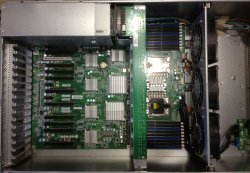Well first I'd like to recommend that you visit the User CP for your account here and change the number of posts per page to 100 instead of the default 25. I wish 100 were the default here actually - then people wouldn't end up saying the same things over and over again in these discussions and we could have a more linear progression of ideas and information. As it is everyone forgets what the thread is about or what has been said, every 25 posts. And it's not about mobile devices because my Android phone loads a page of 100 posts in only a fraction of a second longer than it does for 25.
Anyway, OT suggestions aside, you seem to be asking the right questions - at least from where I sit. But it's not settled out enough for my brain to make intelligent comments. I mean just in this year alone we have been hit with the inundation of SATA III capable devices, TB and TB2 almost back to back, Bluetooth 4.0, USB3.0, mSATA and several mPCIe (card edge) standards, PCIe v3, and the popularizing of (relatively) low cost PCIe direct storage cards - it also looks like we're getting pretty close to seeing PCIe v4 too.
With all this hitting at relatively the same time it's hard to say anything about what will shake out. When comparing MP6,1 TB2 to boxes with PCIe v3 x16 card slots I'd keep in mind a few things:
- There are six full speed TB2 ports capable of about two gigabytes per second each, That's faster than the burst speeds of any three (and most combinations of four) of the fastest SSD drives you can buy in RAID0 - again per TB2 port.
- We're talking about speeds of 2GB/s and per port or not that's more than most cards actually use. Even SAS and SATA RAID cards don't. Sure benchmarking applications do but that's about it. Even most video editors don't use that much bandwidth. 4K to 1080p/60 at 4:4:4 has no call to go over even half that.
- Around 99% of the speed increases people are enjoying from solid-state devices happens at the extreme low end of the bandwidth and is due to severely decreased latency. 99.9% of all I/O happens at under 200MB/s and that's 1/10th the speed TB2 claims.
- As I understand the solid-state storage market prices will not drop like they do with rotational media. Someone here made the argument that R&D is still on-going at a relatively furious pace and this requires large budgets - and so prices won't drop. And this sounds about right to me. Some of these things would seem to suggest that we won't be seeing too many internal 8-drive PCIe devices.
- Internal PCIe (card edge) devices need custom drivers for each OS the company sells them for whereas TB and TB2 needs only one driver and all connected devices just work - much like USB. I think this is much more desirable for OEMs and VARs.
What's going to become popular and take the lead for Desktop and Workstation grade systems? I dunno but another thing to consider is that the MP6,1 is certainly not designed to sit as a file-server. To me it seems feasible that TB2 for the faster devices and USB3 for the more common will become the standards in a year or two.


